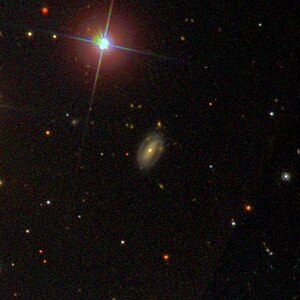IC 2388
| Galaxy IC 2388 |
|
|---|---|

|
|
| AladinLite | |
| Constellation | cancer |
|
Position equinox : J2000.0 , epoch : J2000.0 |
|
| Right ascension | 08 h 39 m 56.5 s |
| declination | + 19 ° 38 ′ 43 ″ |
| Appearance | |
| Morphological type | S. |
| Brightness (visual) | 14.7 mag |
| Brightness (B-band) | 15.5 mag |
| Angular expansion | 0.40 'x 0.2' |
| Position angle | 160 ° |
| Surface brightness | 11.8 mag / arcmin² |
| Physical data | |
| Redshift | 0.032734 ± 0.000155 |
| Radial velocity | 9813 ± 46 km / s |
|
Stroke distance v rad / H 0 |
(434 ± 30) x 10 6 ly (133.2 ± 9.3) Mpc |
| history | |
| discovery | Edward E. Barnard |
| Catalog names | |
| IC 2388 • PGC 24365 • CGCG 089-063 • 2MASX J08395655 + 1938427 • NSA 105344 | |
IC 2388 is a spiral galaxy of Hubble type S in the constellation Cancer on the ecliptic . It is estimated to be 434 million light years away from the Milky Way and has a diameter of about 50,000 ly.
In the same area of the sky are the galaxies NGC 2624 , NGC 2625 , NGC 2637 , IC 2390 , among others .
The object was discovered by Edward Emerson Barnard .
